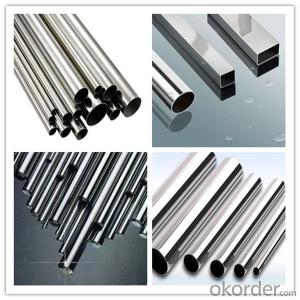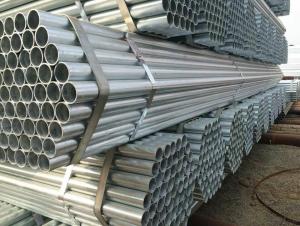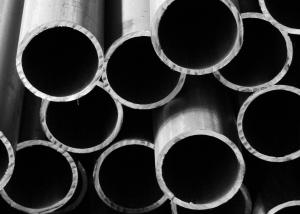STAINLESS STEEL PIPES AND FITTINGS
- Loading Port:
- China Main Port
- Payment Terms:
- TT OR LC
- Min Order Qty:
- -
- Supply Capability:
- -
OKorder Service Pledge
OKorder Financial Service
You Might Also Like
Description:
Stainless Steel Pipe
Material:
304 321 316 310
Packing:
In bundle
MOQ:
5 TONS
Comparison of standardized steels
| EN-standard Steel no. k.h.s DIN | EN-standard Steel name | SAE grade | UNS |
|---|---|---|---|
| 1.4109 | X65CrMo14 | 440A | S44002 |
| 1.4112 | X90CrMoV18 | 440B | S44003 |
| 1.4125 | X105CrMo17 | 440C | S44004 |
| | | 440F | S44020 |
| 1.4016 | X6Cr17 | 430 | S43000 |
| 1.4408 | G-X 6 CrNiMo 18-10 | 316 | |
| 1.4512 | X6CrTi12 | 409 | S40900 |
| | | 410 | S41000 |
| 1.4310 | X10CrNi18-8 | 301 | S30100 |
| 1.4318 | X2CrNiN18-7 | 301LN | |
| 1.4307 | X2CrNi18-9 | 304L | S30403 |
| 1.4306 | X2CrNi19-11 | 304L | S30403 |
| 1.4311 | X2CrNiN18-10 | 304LN | S30453 |
| 1.4301 | X5CrNi18-10 | 304 | S30400 |
| 1.4948 | X6CrNi18-11 | 304H | S30409 |
| 1.4303 | X5CrNi18-12 | 305 | S30500 |
| | X5CrNi30-9 | 312 | |
| 1.4541 | X6CrNiTi18-10 | 321 | S32100 |
| 1.4878 | X12CrNiTi18-9 | 321H | S32109 |
| 1.4404 | X2CrNiMo17-12-2 | 316L | S31603 |
| 1.4401 | X5CrNiMo17-12-2 | 316 | S31600 |
| 1.4406 | X2CrNiMoN17-12-2 | 316LN | S31653 |
| 1.4432 | X2CrNiMo17-12-3 | 316L | S31603 |
| 1.4435 | X2CrNiMo18-14-3 | 316L | S31603 |
| 1.4436 | X3CrNiMo17-13-3 | 316 | S31600 |
| 1.4571 | X6CrNiMoTi17-12-2 | 316Ti | S31635 |
| 1.4429 | X2CrNiMoN17-13-3 | 316LN | S31653 |
| 1.4438 | X2CrNiMo18-15-4 | 317L | S31703 |
| 1.4362 | X2CrNi23-4 | 2304 | S32304 |
| 1.4462 | X2CrNiMoN22-5-3 | 2205 | S31803/S32205 |
| 1.4539 | X1NiCrMoCu25-20-5 | 904L | N08904 |
| 1.4529 | X1NiCrMoCuN25-20-7 | | N08926 |
| 1.4547 | X1CrNiMoCuN20-18-7 | 254SMO | S31254 |
Stainless steel’s resistance to corrosion and staining, low maintenance and familiar lustre make it an ideal material for many applications. There are over 150 grades of stainless steel, of which fifteen are most commonly used. The alloy is milled into coils, sheets, plates, bars, wire, and tubing to be used in cookware, cutlery, household hardware, surgical instruments, major appliances, industrial equipment (for example, in sugar refineries) and as an automotive and aerospace structural alloy and construction material in large buildings. Storage tanks and tankers used to transport orange juice and other food are often made of stainless steel, because of its corrosion resistance. This also influences its use in commercial kitchens and food processing plants, as it can be steam-cleaned and sterilized and does not need paint or other surface finishes.
Stainless steel is used for jewelry and watches with 316L being the type commonly used for such applications. It can be re-finished by any jeweler and will not oxidize or turn black.
Some firearms incorporate stainless steel components as an alternative to blued or parkerized steel. Some handgun models, such as the Smith & Wesson Model 60 and the Colt M1911 pistol, can be made entirely from stainless steel. This gives a high-luster finish similar in appearance to nickel plating. Unlike plating, the finish is not subject to flaking, peeling, wear-off from rubbing (as when repeatedly removed from a holster), or rust when scratched.
Architecture[edit]
Stainless steel is used for buildings for both practical and aesthetic reasons. Stainless steel was in vogue during the art deco period. The most famous example of this is the upper portion of the Chrysler Building (pictured). Some diners and fast-food restaurants use large ornamental panels and stainless fixtures and furniture. Because of the durability of the material, many of these buildings retain their original appearance.
Type 316 stainless is used on the exterior of both the Petronas Twin Towers and the Jin Mao Building, two of the world's tallest skyscrapers.[17]
The Parliament House of Australia in Canberra has a stainless steel flagpole weighing over 220 tonnes (240 short tons).
The aeration building in the Edmonton Composting Facility, the size of 14 hockey rinks, is the largest stainless steel building in North America.
Bridges[edit]
Cala Galdana Bridge in Minorca (Spain) was the first stainless steel road bridge.
Sant Fruitos Pedestrian Bridge (Catalonia, Spain), arch pedestrian bridge.
Padre Arrupe Bridge (Bilbao, Spain) links the Guggenheim museum to the University of Deusto.[18]
Monuments and sculptures[edit]
The Unisphere, constructed as the theme symbol of the 1964-5 World's Fair in New York City, is constructed of Type 304L stainless steel as a sphere with a diameter of 120 feet, or 36.57 meters.
The Gateway Arch (pictured) is clad entirely in stainless steel: 886 tons (804 metric tonnes) of 0.25 in (6.4 mm) plate, #3 finish, type 304 stainless steel.[19]
The United States Air Force Memorial has an austenitic stainless steel structural skin.
The Atomium in Brussels, Belgium was renovated with stainless-steel cladding in a renovation completed in 2006; previously the spheres and tubes of the structure were clad in aluminium.
The Cloud Gate sculpture by Anish Kapoor, in Chicago US.
The Sibelius monument in Helsinki, Finland, is made entirely of stainless steel tubes.
The Man of Steel (sculpture) under construction in Rotherham, England.
Other[edit]
- Automotive bodies
The Allegheny Ludlum Corporation worked with Ford on various concept cars with stainless steel bodies from the 1930s through the 1970s, as demonstrations of the material's potential. The 1957 and 1958 Cadillac Eldorado Brougham had a stainless steel roof. In 1981 and 1982, the DeLorean DMC-12 production automobile used stainless steel body panels over a glass-reinforced plasticmonocoque. Intercity buses made by Motor Coach Industries are partially made of stainless steel. The aft body panel of the Porsche Cayman model (2-door coupe hatchback) is made of stainless steel. It was discovered during early body prototyping that conventional steel could not be formed without cracking (due to the many curves and angles in that automobile). Thus, Porsche was forced to use stainless steel on the Cayman.
- Passenger rail cars
Rail cars have commonly been manufactured using corrugated stainless steel panels (for additional structural strength). This was particularly popular during the 1960s and 1970s, but has since declined. One notable example was the early Pioneer Zephyr. Notable former manufacturers of stainless steel rolling stock included the Budd Company (USA), which has been licensed to Japan's Tokyu Car Corporation, and the Portuguese company Sorefame. Many railcars in the United States are still manufactured with stainless steel, unlike other countries who have shifted away.
- Aircraft
Budd also built an airplane, the Budd BB-1 Pioneer, of stainless steel tube and sheet, which is on display at the Franklin Institute.
The American Fleetwings Sea Birdamphibious aircraft of 1936 was also built using a spot-welded stainless steel hull.
The Bristol Aeroplane Company built the all-stainless steel Bristol 188 high-speed research aircraft, which first flew in 1963.
The use of stainless steel in mainstream aircraft is hindered by its excessive weight compared to other materials, such as aluminum.
- Jewelry
Valadium, a stainless steel and 12% nickel alloy is used to make class and military rings. Valadium is usually silver-toned, but can be electro-charged to give it a gold tone. The gold tone variety is known as Sun-lite Valadium
- Q: Can stainless steel pipes be used for underground sewer lines?
- Certainly! Stainless steel pipes are suitable for underground sewer lines. Due to its remarkable durability and resistance to corrosion, stainless steel is an optimal material selection for harsh environments, including underground sewer systems. It offers exceptional protection against chemicals, moisture, and other corrosive elements frequently encountered in sewer lines. Moreover, stainless steel pipes boast an extended lifespan and necessitate minimal upkeep, proving to be an economical choice over time. Nevertheless, it is crucial to account for the particular specifications and regulations of the local sewer system before opting for stainless steel pipes in underground applications.
- Q: Can stainless steel pipes be used for irrigation systems?
- Yes, stainless steel pipes can be used for irrigation systems. Stainless steel is a durable and corrosion-resistant material, making it suitable for use in irrigation systems where water exposure is constant. Additionally, stainless steel pipes are known for their longevity and ability to withstand high pressure, making them a reliable choice for irrigation applications.
- Q: Can stainless steel pipes be used for drinking water supply?
- Yes, stainless steel pipes can be used for drinking water supply. Stainless steel is resistant to corrosion, making it a safe and reliable material for transporting drinking water. It does not leach harmful chemicals into the water and is highly durable, making it suitable for long-term use in water supply systems.
- Q: How do stainless steel pipes compare to other materials like copper or PVC?
- Stainless steel pipes offer distinct advantages over materials like copper or PVC. Stainless steel pipes are highly durable, corrosion-resistant, and suitable for various applications, even in harsh environments. Unlike copper, stainless steel does not react with water or other substances, ensuring the purity of the transported fluids. Additionally, stainless steel pipes have a higher strength-to-weight ratio than PVC, making them more robust and long-lasting. While copper and PVC have their own merits, stainless steel pipes excel in terms of longevity, reliability, and overall performance.
- Q: Are stainless steel pipes suitable for marine applications?
- Yes, stainless steel pipes are suitable for marine applications. Stainless steel is highly resistant to corrosion and can withstand the harsh conditions of saltwater, making it a popular choice for marine applications such as shipbuilding, offshore structures, and marine equipment. It provides excellent durability, strength, and long-term performance in marine environments.
- Q: Can stainless steel pipes be insulated?
- Indeed, it is possible to insulate stainless steel pipes. Insulation is frequently employed on pipes in order to prevent the loss or gain of heat, and stainless steel pipes are not exempt from this practice. The insulation of stainless steel pipes offers numerous advantages, including the reduction of energy expenses, prevention of condensation, and maintenance of the fluid's temperature within the pipe. Diverse insulation materials, such as fiberglass, foam, or mineral wool, can be utilized to insulate stainless steel pipes, depending on the specific requirements of the given application. The insulation of stainless steel pipes is a widespread procedure in industries such as oil and gas, chemical processing, and HVAC systems.
- Q: Can stainless steel pipes be galvanized?
- Yes, stainless steel pipes can be galvanized. Galvanization is a process in which a protective zinc coating is applied to steel or iron to prevent rusting. While stainless steel is already highly resistant to corrosion, galvanizing can provide an additional layer of protection in certain applications. However, it is important to note that galvanizing stainless steel pipes is not as common as galvanizing carbon steel pipes, as the inherent corrosion resistance of stainless steel is often sufficient for most applications. Additionally, galvanizing stainless steel can alter its appearance and may not be suitable for certain aesthetic requirements.
- Q: What is the maximum temperature for stainless steel pipes?
- The specific grade of stainless steel used determines the maximum temperature for stainless steel pipes. High temperatures up to 1600-1800°F (870-980°C) can generally be handled by austenitic stainless steels like grades 304 and 316. However, factors like exposure duration, corrosive environments, and application requirements should be taken into account. Different grades, such as ferritic or martensitic stainless steels, might have lower maximum temperature limits. To establish the suitable maximum temperature for a specific stainless steel pipe, it is recommended to refer to the manufacturer's specifications and engineering guidelines.
- Q: Can stainless steel pipes be used for chemical processing plants?
- Yes, stainless steel pipes can be used for chemical processing plants. Stainless steel is highly resistant to corrosion and can withstand the harsh chemicals and high temperatures often found in chemical processing plants. It also maintains its strength and durability over time, making it a suitable choice for transporting and storing various chemicals in such facilities.
- Q: What is the corrosion resistance of stainless steel pipes?
- Stainless steel pipes offer excellent corrosion resistance due to the presence of chromium in their composition. Chromium reacts with oxygen in the atmosphere to form a thin, protective layer of chromium oxide on the surface of the pipe. This oxide layer acts as a barrier, preventing further oxidation and corrosion of the underlying metal. Additionally, stainless steel pipes are often alloyed with other elements such as nickel and molybdenum, which further enhance their corrosion resistance. As a result, stainless steel pipes are highly resistant to rust, pitting, and other forms of corrosion, making them suitable for a wide range of applications in various industries, including plumbing, oil and gas, chemical processing, and marine environments.
Send your message to us
STAINLESS STEEL PIPES AND FITTINGS
- Loading Port:
- China Main Port
- Payment Terms:
- TT OR LC
- Min Order Qty:
- -
- Supply Capability:
- -
OKorder Service Pledge
OKorder Financial Service
Similar products
Hot products
Hot Searches
Related keywords






















